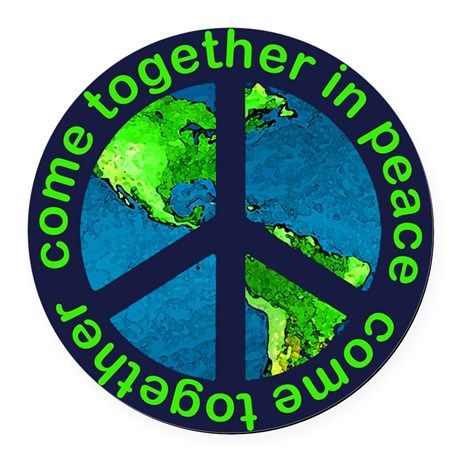In 1958, amid growing fears of Cold War nuclear proliferation, thousands of people gathered in London’s Trafalgar Square on Good Friday. The protesters were there to embark on a 50-mile march to the Atomic Weapons Research Establishment in Aldermaston, a small village where England carried out weapons research, production, and testing. The demonstration was the work of the Direct Action Committee Against Nuclear War (DAC) and the newly formed Campaign for Nuclear Disarmament (CND), and it featured the debut of an image that became one of the most recognized protest symbols in the world: the peace symbol.
The emblem was designed by English artist Gerald Holtom, a pacifist and conscientious objector during World War II. His design was stark, yet powerful: a circle, symbolizing Earth, with downward-pointing lines inside, forming the shape of the letter “N” and the letter “D,” for “Nuclear Disarmament.” The symbol also held deeper layers of symbolism for Holtom. In a letter to Hugh Brock, editor of the British pacifist magazine Peace News, Holtom revealed that he saw the symbol as somewhat of a self-portrait, capturing an individual in despair, standing with outstretched hands. The artist also named Spanish Romantic painter Francisco Goya‘s 1814 painting The Third of May 1808, which portrayed civilian resistance to war, as an influence on his design.
 Before long, the CND symbol had made its way across the Atlantic, where it shed its strict nuclear arms association and was used as a sign of peace during civil rights demonstrations. Although the symbol’s exact path to America isn’t known, it seems most likely to have been brought over by Bayard Rustin, a close associate of Martin Luther King Jr. who was at the 1958 London protest. Peace activist Philip Altbach has also claimed he brought CND buttons to his colleagues after a trip to England, introducing Americans to the symbol for the first time.
Before long, the CND symbol had made its way across the Atlantic, where it shed its strict nuclear arms association and was used as a sign of peace during civil rights demonstrations. Although the symbol’s exact path to America isn’t known, it seems most likely to have been brought over by Bayard Rustin, a close associate of Martin Luther King Jr. who was at the 1958 London protest. Peace activist Philip Altbach has also claimed he brought CND buttons to his colleagues after a trip to England, introducing Americans to the symbol for the first time.
The symbol’s power became palpable as the Vietnam War escalated in the mid-1960s. It was embraced by anti-war activists, and was even seen drawn on U.S. soldiers’ helmets in Vietnam. By 1969, the symbol had evolved into a more general icon of peaceful protest and living in harmony. The peace sign featured prominently at Woodstock, and became an emblem of the hippie counterculture. Today, the Woodstock Museum and New York’s Bethel Woods Center for the Arts etch a peace symbol into the former festival grounds each year.
For as widely as the peace symbol has been embraced over the years, however, it has also faced misinterpretation and criticism. Christian groups have construed it as a broken, reversed cross. Its anti-war association had it condemned as a communist symbol, and it has also been compared to a runic symbol for death. Nevertheless, the simple visual has endured as a totem of nonviolent activism, and it continues to be used in advocacy for conflict resolution, LGBTQ+ rights, and various other social justice issues. As far as South Africa, the sign was adopted as a powerful symbol of the resistance to apartheid, which even caused the government to attempt to ban the symbol in 1973.
criticism. Christian groups have construed it as a broken, reversed cross. Its anti-war association had it condemned as a communist symbol, and it has also been compared to a runic symbol for death. Nevertheless, the simple visual has endured as a totem of nonviolent activism, and it continues to be used in advocacy for conflict resolution, LGBTQ+ rights, and various other social justice issues. As far as South Africa, the sign was adopted as a powerful symbol of the resistance to apartheid, which even caused the government to attempt to ban the symbol in 1973.
The peace sign’s designer, Holtom, did once express some regret over the final design of his original nuclear disarmament symbol. In an unused design, which was upside-down from the final image, the letter “N” was instead a “U.” Holtom saw this as a way to signify a broader disarmament — a “unilateral” one. Given the peace symbol’s universality, his instincts have proved correct either way, and his creation remains an aspirational symbol for a more peaceful and equitable world.
Media Release/HistoryFacts


